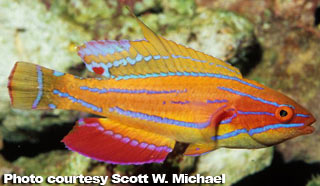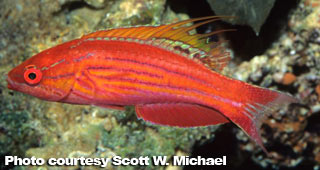|
This genus contains at least 16 extraordinary species. They are often overlooked because of their small size and because they are often placed in holding tanks where they hide or do not show off their true beauty. The flasher wrasses are not a threat to invertebrates, with the possible exception of small anemone shrimp (Periclimenes spp.) As a result, they are welcome introductions to the invertebrate tank. They are also great for reef tanks because they spend most of their time in the water column and serve as "dither" fish, encouraging shy fishes to spend more time in the open.
These wrasses adapt readily to captivity, especially if housed with other peaceful fishes. They are best kept in small groups, but make sure you add all of them at the same time or put the less aggressive females in before the male. It is best to only house one male flasher wrasse per tank. While I have kept males of different species together in larger aquariums, it is not without risk. Oftentimes, one of the males (usually the larger of the bunch) will begin incessantly picking on congeners of the same species. This usually leads to the demise of the other males in the tank. One of the most rewarding things about keeping flasher wrasses in groups is that the males will display more if females are present. These colorful displays are important in courtship. Solitary males will occasionally "flash" at their reflections in the aquarium glass.
 With the possible exception of close relatives (e.g., fairy wrasses) or other small planktivores (e.g., fire gobies), flasher wrasses are rarely aggressive toward other fishes. These infrequent bouts of aggression usually consist of displaying or, on rare occasion, they may chase a newly introduced fish.
With the possible exception of close relatives (e.g., fairy wrasses) or other small planktivores (e.g., fire gobies), flasher wrasses are rarely aggressive toward other fishes. These infrequent bouts of aggression usually consist of displaying or, on rare occasion, they may chase a newly introduced fish.
Although your chances of success are reduced, I have seen flasher wrasses in reef tanks with larger or more aggressive fishes. For example, a friend of mine has several flasher wrasses in a large tank (i.e., 180 gallon) with eight species of surgeonfish, a flameback angelfish (Centropyge acanthops), smaller dottybacks, basslets and other wrasses. But their enemies do include aggressive pygmy angelfishes, dottybacks, larger damsels, hawkfishes, large fairy wrasses (especially if these wrasses are introduced before them), wrasses in the genus Pseudocheilinus, Thalassoma, and larger Halichoeres spp., tangs and any fish that can swallow them (e.g., frogfishes, scorpionfishes, groupers). They are particularly vulnerable to combative species in smaller aquariums. If they are persistently harassed when introduced to a tank, they will hide and never come out to feed. Therefore, if you are going to keep them with potentially quarrelsome fish, they should be the first fish added to the tank after it has cycled.
 Flasher wrasses also have invertebrate foes; they have been known to fall victim to predatory crustaceans (e.g., large hermit crabs, cancrid crabs), Elephant Ear Polyps (Amplexidiscus fenestrafer) and Carpet Anemones (Stichodactyla spp.).
Flasher wrasses also have invertebrate foes; they have been known to fall victim to predatory crustaceans (e.g., large hermit crabs, cancrid crabs), Elephant Ear Polyps (Amplexidiscus fenestrafer) and Carpet Anemones (Stichodactyla spp.).
Flasher wrasses should be fed two or three times a day in order to maintain their body weight. Since they feed on zooplankton and rarely pick at organisms on live rock, they will not thrive in the reef tank if they are fed infrequently. A good
protein skimmer and Live Sand will help decrease the build-up of dissolved organics that may result from this more regular feeding regime. Avoid purchasing specimens that show signs of emaciation, like a pinched-in stomach or atrophied dorsal musculature. Although they can contract ich (Cryptocaryon irritans), they are not especially susceptible to this infection. Like all your newly acquired specimens, they should be quarantined before they are added to the display tank.
Part 1
Introduction |
| |
Part 2
Fairy Wrasses
(genus Cirrhilabrus) |
| |
Part 3
Flasher Wrasses
(genus Paracheilinus) |
| |
Part 4
Pinkstreaked Wrasse
(genus Pseudocheilinops) |
| |
Part 5
Lined Wrasses
(genus Pseudocheilinus) |
| |
Part 6
Possum Wrasses
(genus Wetmorella) |

 Scott Michael
Scott Michael
Scott W. Michael is an internationally-recognized writer, underwater photographer, and marine biology researcher specializing in reef fishes, and was the Banquet Speaker at our 2007 and 2008 Coral Conference and Frag Swap. He is a regular contributor to Aquarium Fish Magazine, Freshwater and Marine Aquarium Magazine, SeaScope, and is the author of
Reef Fishes Vol 1,
Vol 2, and
Vol 3, Vol 4, and Vol 5.,
A Pocket Expert Guide Marine Fishes,
A Pocket Expert Guide to Reef Aquarium Fishes, 101 Best Saltwater Fishes: How to Choose and Keep Hardy, Brilliant, Fascinating Species That Will Thrive in Your Home Aquarium, Reef Sharks & Rays of the World, and Aquarium Sharks & Rays. Having studied marine biology at the University of Nebraska, Scott has served as a scientific consultant for National Geographic Explorer, the Discovery Channel, and French educational television.
|